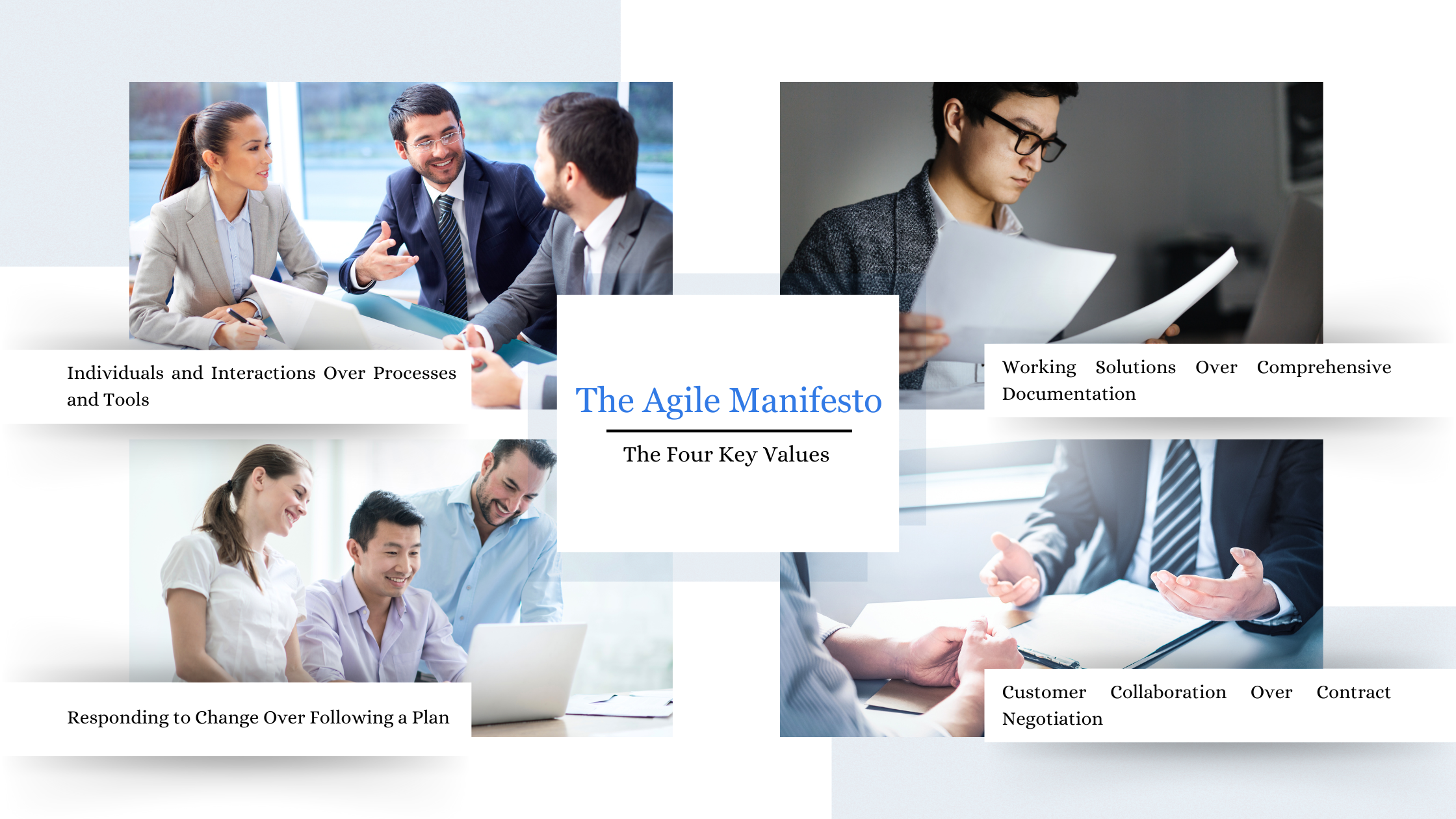MODIFIED ON: June 7, 2024 / ALIGNMINDS TECHNOLOGIES / 0 COMMENTS

Introduction
Imagine a world where building products is like conducting a harmonious orchestra. Change isn’t just accepted; it’s celebrated, and the customer’s needs always take centre stage. This is the world of the Agile Manifesto.
Agile development methods have revolutionized product engineering, making it faster, adaptable, and customer-focused.
Take Spotify, the renowned music streaming company, for instance. They’re a prime example of how Agile thinking can lead to incredible success. By listening to users and releasing frequent updates, they soared to the top of the music streaming industry.
To learn how Agile Development and Methodologies work team up with a product engineering company in US or anywhere across the world. They can help you see how the Agile Manifesto can guide your success in product engineering. But first, let’s cover the basics!
The Agile Manifesto: The Four Key Values

1. Individuals and Interactions Over Processes and Tools
In Agile, people come first. Human interactions and teamwork are at the core. Agile teams collaborate closely, communicate effectively, and embrace change, making individuals the heart of project success.
2. Working Solutions Over Comprehensive Documentation
Unlike traditional methods with extensive documentation, Agile prioritizes functional solutions. While documentation is important, Agile focuses on delivering working products early and frequently, ensuring they match customer needs.
3. Customer Collaboration Over Contract Negotiation
Agile promotes customer collaboration throughout the project. Instead of rigid contracts, Agile teams involve customers in decision-making and gather regular feedback, aligning the final product with customer expectations and market demands.
4.Responding to Change Over Following a Plan
Agility is essential in the Agile Manifesto. Teams embrace change rather than sticking to a fixed plan, staying responsive to evolving requirements and market dynamics, which leads to relevant and competitive products.
The Agile Manifesto: The Twelve Principles
Principle 1: Prioritize Customer Satisfaction
In Agile, customer satisfaction is king. Teams continuously deliver value to customers through working solutions and by adapting to customer feedback.
Principle 2: Embrace Changing Requirements
Agile acknowledges that change is inevitable. Teams welcome changing requirements, even late in the development process, ensuring the final product meets customer needs.
Principle 3: Deliver Incremental Progress
Agile promotes incremental progress. Instead of a complete product at the project’s end, Agile teams deliver smaller increments regularly, allowing early and frequent feedback to reduce project risk.
Principle 4: Collaborate Closely

Team members, customers, and stakeholders collaborate closely, fostering communication, transparency, and shared understanding.
Principle 5: Build Motivated Teams
Agile principles value motivated individuals and teams, empowering them to self-organize and stay motivated.
Principle 6: Communicate Face-to-Face
While digital communication is important, Agile values face-to-face interactions, enhancing communication, trust, and collaboration.
Principle 7: Measure Progress with Working Software
Agile measures progress through functional software, allowing better decision-making and keeping the project on track.
Principle 8: Maintain a Sustainable Pace
Agile recognizes the importance of a sustainable work pace, preventing burnout and ensuring consistent work rhythm for long-term success.
Principle 9: Maintain Technical Excellence
Agile teams prioritize technical excellence through design, code quality, and automated testing, ensuring long-term product maintainability.
Principle 10: Keep It Simple
Simplicity is key in Agile. Teams focus on delivering the simplest, most valuable solutions to minimize waste and maximize efficiency.
Principle 11: Self-Organize
Agile teams are encouraged to self-organize, make decisions and adapt to changing circumstances for more efficient project management.
Principle 12: Reflect and Adjust
Agile teams continuously reflect on their processes and outcomes, adapting to improve their performance and deliver better results.
How the Agile Manifesto Drives Product Engineering Success?

Now, let’s see how these values and principles can lead to product engineering success:
Embracing Change and Flexibility with Agile Development Process
Agile Manifesto places a high value on embracing change, which is vital in the fast-paced world of product engineering. Agile methodologies enable teams to adapt swiftly by continuously gathering feedback and reevaluating priorities, ensuring the end result aligns with customer needs.
Collaborative Work Environment with Agile Methodology
Agile methodologies promote collaboration among cross-functional teams, fostering innovation and utilizing everyone’s expertise. Connect with a product engineering company in India or anywhere across the globe to know how this collaborative approach leads to flourishing product engineering.
Customer-Centric Approach with Agile Development Process
In Agile, the customer takes the spotlight. Regular customer feedback and iterative improvements ensure that products meet their requirements, driving the success of product engineering.
Continuous Improvement with Agile Methodology
Agile principles emphasize continuous improvement through regular retrospectives, identifying areas for enhancement and proactive steps. This iterative process keeps the product aligned with ever-changing market demands.
Iterative Development with Agile Development Process
Agile methodologies break the development process into smaller, manageable iterations, allowing teams to deliver valuable features quickly, reducing time-to-market, and enhancing the product’s competitiveness.
Transparency and Communication with Product Engineering
Transparent communication is essential for Agile success. Effective communication within the team and with stakeholders keeps everyone aligned on the project’s progress and goals, reducing misunderstandings and building trust.
Make it happen with AlignMinds:

Remember, the Agile Manifesto isn’t just a methodology; it’s a recipe for product engineering success and you can easily make this happen with AlignMinds.
At AlignMinds, we’re not your typical digital transformation company. We’re your partners in bringing your product engineering dreams to life, especially in the ever-evolving areas of mobility and cloud platforms.
Here’s how we use the Agile Manifesto to drive your product engineering success:
Customer-Centric Approach: We follow Agile principles and believe in putting the customer at the center of the process.
Certified Scrum Masters:Our team includes certified Scrum Masters who are experts at facilitating the Agile process.
Cutting-Edge Technology:We stay ahead of the curve by using the latest technologies and tools to craft innovative and scalable solutions.
Flexible Engagement: We get it, every project is unique. We offer flexible engagement models that fit your budget, timeline, and scope.
Product Innovation: We love a good challenge. Our product innovation mindset allows us to tackle complex problems and create value for you.
We’re not just a company; we’re your dedicated team, ready to transform your digital vision into reality. Visit our website to learn more:AlignMinds.
Leave a reply
Your email address will not be published.
-
Recent Posts
- The Ultimate 4-Step Guide to Modernizing Your Applications
- The 12 Most Popular Computer Vision Tools in 2024
- How MLOps is Transforming Businesses in 2024
- The Ultimate Guide to Product Engineering Services for Businesses
- 5 Top Use Cases of Computer Vision in the Hospitality Industry
-
Categories
- MVP Development (5)
- AlignMinds (55)
- Operating Systems (1)
- Android POS (3)
- Application Hosting (1)
- Artificial Intelligence (23)
- Big Data (2)
- Blockchain (1)
- Cloud Application Development (7)
- Software Development (29)
- Software Testing (9)
- Strategy & User Experience Design (4)
- Web Application Development (23)
- Cyber Security (6)
- Outsourcing (7)
- Programming Languages (3)
- DevOps (5)
- Software Designing (6)
- How to Code (4)
- Internet of Things (1)
- Machine Learning (2)
- Mobile App Marketing (4)
- Mobile Application Development (18)
- Mobile Applications (5)







